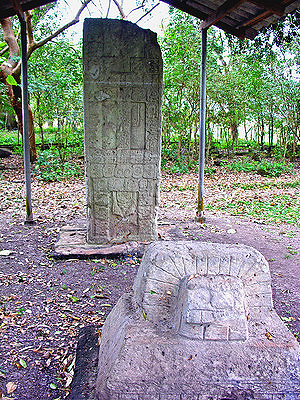Stela J
Location: Eastern Entrance Las Sepulturas
Dates: 702
Rulers: 13, 12, 1
Measurements: 8.92 feet x 2.92 feet x 2.36 feet, cribbing 5.58 feet

Dennis J. Honduras-0294, 2007, photograph. Flickr.
At the eastern entrance to the village stands Waxaklajuun Ubaah K’awiil’s first monument, erected seven years after his accession (Martin and Grube 2008, 203). The stela was created to celebrate his first period ending as king (Fash 1991, 150). So early into his reign, he had yet to develop his signature elaborate, high relief style. Stela J was created in low relief and is the only surviving stela created by the thirteenth ruler in the village (Fash 1991, 113). Yet, the stela was still elaborate and unique with exceptional detail on its two figured sides, neither of which depict a human subject. With text on the sides and two sides containing figural imagery, one may classify this stela as a Type V, although text is largely present on all four sides (Fash 2004, 259).
The stela was sealed to a cruciform chamber sealed with cribbing containing a large shell, pottery, and a white stone stained red (Baudez 1994, 69). A stone roof is erected over the monument, a rare evocation of a house (Martin and Grube 2008, 203). The eastern side has an elaborate mat design while the eastern sign has Witz imagery, including filed incisors and a T shaped image resembling a bunch of grapes, although the latter more often represents tuun or stone (Baudez 1994, 69-70). Also evoking the mat motif, a portion of the historical text on its eastern side is braided with itself, rendering the meaning nearly indecipherable (Martin and Grube 2008, 203; Looper 2003, 235). The mat motif represents royalty, and in the east represents the rise of the thirteenth ruler in the first period ending after his accession. The Earth Monster imagery is also reminiscent of jaguar iconography on loincloths (Baudez 1994, 69).
Stela J has an altar with a jaguar head on a pyramidal base situated three meters west of it (Baudez 1994, 70). The base of the pyramid has crossed bands like the founding glyph, perhaps evoking Yax K’uk’ Mo’ (Baudez 1994, 71). Baudez describes the altar’s jaguar head against the eastern side of Stela J as the rising of the nocturnal sun (1994, 71). The Earth Monster on the west may also invoke the Underworld and the king’s connection with the ancestors and the supernatural.
The text itself mentions both K’ahk Uti’ Witz’ K’awiil’s accession date as well as Yax K’uk’ Mo’ during the 9.0.0.0.0 period ending. Notably, this monument mentioning the bak’tun ending was erected after the twelfth ruler’s tomb was finished in 695, burying the Papagayo Structure and Stela 63 along with it (Martin and Grube 2008, 203). Popol Hol’s monument to his and his father’s witness of the bak’tun ending had been accessible for roughly 120 years beforehand. Stela 63 had replaced the Motmot Marker before it, and Bahlam Nehn had later erected Stela 15 also commemorating this event (Fash 1991, 83). Given its creation after the twelfth ruler’s tomb, Stela J may have served as a replacement.
Standing in front of the entrance to the village, and therefore the city, Stela J announces the glory of the Founder by commemorating the bak’tun ending, pays respect to his predecessor by acknowledging his accession date, and celebrates his own accession with the stela’s imagery and previous two purposes. Anyone entering the city would witness the rise of the king and lineage’s glory.
In 751, K’ahk’ Tiliw Chan Yopaat, the Quirigua king who killed Waxaklajuun Ubaah K’awiil would imitate this stela as a method of claiming Copan’s power. Quirigua’s Stela H would also include the mat pattern, diagonal text, location at the entrance, and be erected in the first major period ending after K’ahk’ Tiliw Chan Yopaat’s accession (Martin and Grube 2008, 221; Fash 1991, 150). As Quirigua had yet to reach the pinnacle of its carving skill, these imitations would pale in comparison to the original. Later monuments, such as Quirigua’s own Stela J, would eventually rival even Copan (Martin and Grube 2008, 221).
Motifs
- Crossed Bands Glyph
- Bunch of Grapes
- East/West
- House
- Intertwined Glyphs
- Jaguar
- Mat Pattern
- Witz
See Also:
Sources:
- Baudez, Claude-François. 1994. Maya Sculpture of Copán: The Iconography. Norman: University of Oklahoma Press.
- Fash, Barbara W. 2004. “Early Classic Sculptural Development at Copan.” In Understanding Early Copan, edited by Ellen E. Bell, Marcello A. Canuto, & Robert J. Sharer, 249-264. Philadelphia: University of Pennsylvania Museum of Archaeology and Anthropology
- Fash, William L, 1991. Scribes, Warriors, and Kings: The City of Copán and the Ancient Maya. New York: Thames and Hudson.
- Looper, Matthew George. 2003. Lightning Warrior: Maya Art and Kingship at Quirigua. Austin: University of Texas Press.
- Martin, Simon and Nikolai Grube. 2008. Chronicle of the Maya Kings and Queens London: Hudson and Thames
Photograph
- Honduras-0294, by Dennis Jarvis, is licensed by CC-BY-SA-2.0.